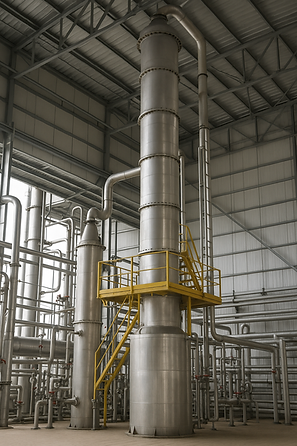
Distillation
Distillation is the fire that gives shape to tequila. If fermentation is the beating heart, here the voice of the spirit is refined. From the first copper stills brought by the conquistadors to the modern stainless steel columns, this step has been the bridge between the tradition of agave and the clarity of the distillate.
I. History of Distillation
In the beginning, distillation was carried out in rudimentary copper and clay stills, brought to New Spain by the Spanish, who in turn had learned the art from the Arabs. These small boilers were fragile, but they opened the door to something unprecedented: transforming agave ferments into a strong, clear, and lasting liquid.
Over time, tequila haciendas adopted larger and more resistant copper stills. Each drop fell slowly, as if carved by fire. In these shining pieces hid the alchemy that turned the bubbling must into a distillate with soul.
By the 20th century, with the growth of the industry, stainless steel distillation columns were incorporated, capable of processing larger volumes with precision and uniformity. Their imposing height marked a new era, where purity was achieved efficiently, without losing the essential principle that remains the same after centuries: separating the transient from the essential.
II. The Distillation Process
Distillation is, in essence, a dialogue between fire and agave. The fermented must—this living liquid that bubbled for days in the tanks—enters the still and, with heat, begins to transform.
First distillation (ordinario): The must is heated and the alcohol vapors rise slowly. It is as if the spirit of the agave sought to escape in the form of vapor. As they cool in the coils, those vapors return to liquid. The result is a turbid and strong distillate, but still immature, known as “ordinario.” Here there are still impurities and the flavor is not yet defined; it is like a first draft of tequila.
Second distillation (rectification): The “ordinario” returns to the still for a second purification. This time, the fire works with more patience and the master tequilero makes the cuts: separating the “heads” (the first vapors, with pungent and undesirable aromas), the “hearts” (the noble and balanced part that will become tequila), and the “tails” (the heavy and harsh end). Only the heart is kept, and from it comes the bright, transparent, and strong tequila we know. It usually comes out between 55 and 60 degrees of alcohol, a strength not yet suitable for direct drinking, but one that concentrates all the freshness and character of agave.
After this double distillation, the liquid is adjusted with pure water until it reaches its final graduation: normally 38–40% in Mexico and 40% in the international market. At this point, tequila is ready to move on to another stage of its life: aging in barrels or being bottled as young and crystalline.
Although the principle is simple—heat, evaporate, and condense—the true art lies in the hand of the master tequilero. He decides the rhythm of the fire, the exact moment of the cuts, and the way to guide the distillate. It is a craft learned over the years, passed down from generation to generation.
In simple words: distillation is like a filter of fire. It leaves behind what is unnecessary and rescues the essential. That is why every drop that falls from the still is already pure spirit of agave.

“In ancient copper burned the first voice of tequila.
Drop by drop, the fire sketched the spirit of agave,
and the haciendas kept in silence the secret of its birth.”

“Copper still lives in today’s distilleries.
Shining and lined in series,
it preserves the tradition of patient fire,
where agave is transformed into spirit with the same nobility of the past.”

“In the steel columns, distillation becomes faster and more precise.
Their greatness lies in scale,
but many still remember that the true character of tequila
is forged more slowly, drop by drop, in copper.”


